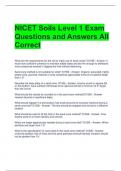Exam (elaborations)
NICET Soils Level 1 Exam Questions and Answers All Correct
- Course
- Institution
NICET Soils Level 1 Exam Questions and Answers All Correct What are the requirements for the soil to make use of sand cones? D1556 - Answer- It must have sufficient cohesion to maintain stable sides and be firm enough to withstand minor pressures exerted in digging the hole without deforming ...
[Show more]





